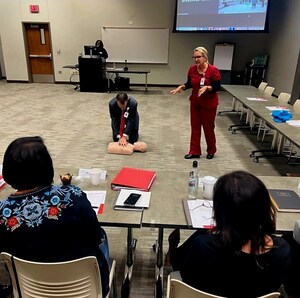Stroke Patients Benefit From Family Involvement in Exercise Therapy
DALLAS, March 4, 2011 /PRNewswire-USNewswire/ -- Your family's involvement in your exercise therapy could significantly improve your function and recovery after stroke, according to a study in the March print issue of Stroke: Journal of the American Heart Association.
(Logo: http://photos.prnewswire.com/prnh/20100222/AHSALOGO)
Researchers found that adding family-assisted exercise therapy to routine physical therapy after stroke improved motor function, balance, distance walked and ability to perform daily living activities. It also lowered the strain on the family member, who said participation lowered stress and was empowering.
"It's a win-win situation for everyone," said Emma Stokes, Ph.D., the study's principal investigator and Senior Lecturer in Physiotherapy at Trinity College Dublin in Ireland. "People with stroke, their families and healthcare providers share in the benefit."
The study involved 40 male and female stroke survivors, all Caucasian. Half received routine exercise therapy, while the others received the FAmily Mediated Exercise intervention (FAME) in addition to routine therapy.
The routine exercise therapy group included seven men and 13 women, average age 70. The FAME group had 13 men and seven women, average age 63. Family members helped the stroke patient do exercises in 35-minute increments seven days per week for eight weeks to improve leg function. The exercises were simple enough to be done at the bedside, either at the hospital or at home. Exercise was tailored to each individual and modified weekly to reflect improvement. Researchers assessed the outcome of the two groups after the treatment period and at three-month follow-up.
Rose Galvin Ph.D., FAME's research physiotherapist conducted brief training sessions for the participating family members and met with them on a weekly basis.
Length of hospital stay in the family exercise group was an average 35 days compared to 40 days in the routine exercise group.
Researchers found statistically significant differences between FAME patients vs. routine care patients in eight measures of impairment and activity. For example, in the six-minute walk test, the routine group walked about 47 meters (154 feet) more after receiving therapy, while the FAME group walked about 164 meters (538 feet) more compared to baseline. Moreover, the FAME group survivors were significantly more integrated into their community at follow-up.
Family members who participated in the exercise therapy also experienced a major benefit.
"Instead of adding burden to the caregiver, participating in exercise actually enabled the family member to do something practical for their loved one in hospital," Stokes said. "Caregivers were less stressed and more empowered."
Co-authors are: Rose Galvin, Ph.D.; Tara Cusack, Ph.D., Eleanor O'Grady, BS.C.; and Brendan Murphy, Ph.D., University College Dublin. Author disclosures are on the manuscript.
The study was funded by the Irish Heart Foundation, Medical Research Charities Group, The Friends of the Royal Hospital Donnybrook, the O'Driscoll/O'Neill bursary in conjunction with the Irish Society of Chartered Physiotherapists (2006) and the Seed Funding Scheme in University College Dublin.
Additional Resources:
- American Stroke Association
- Stroke types, warning signs and risk factors
- Online information and tools to about cardiac rehabilitation can be found at www.heart.org/cardiacrehab.
- All multimedia elements are located at www.heart.org/news under Multimedia.
CONTACT
For information, contact:
Karen Astle: (214) 706-1392; [email protected]
Bridgette McNeill: (214) 706-1135; [email protected]
Julie Del Barto (broadcast): (214) 706-1330; [email protected]
SOURCE American Heart Association
WANT YOUR COMPANY'S NEWS FEATURED ON PRNEWSWIRE.COM?
Newsrooms &
Influencers
Digital Media
Outlets
Journalists
Opted In






Share this article